An Impressive Place
I spent my twentieth year in a program called College Year In Athens which was based in Athens, Greece, but included trips all over the country. During one of those trips the bus drove through a dusty, little town in the Peloponnese, and then stopped. We stumbled out into the bright sun and a professor pointed to a fenced-off hill and said having to do with ancient Argos. I was too groggy to hear. Then we piled back onto the bus and drove on through the town.1
Argos looked and looks like this:
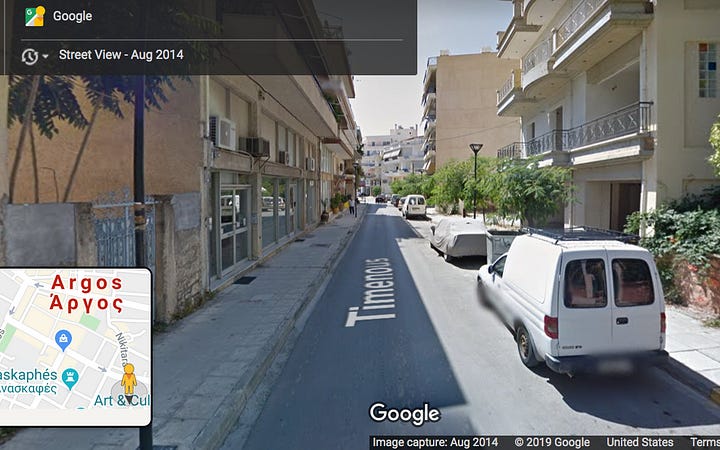

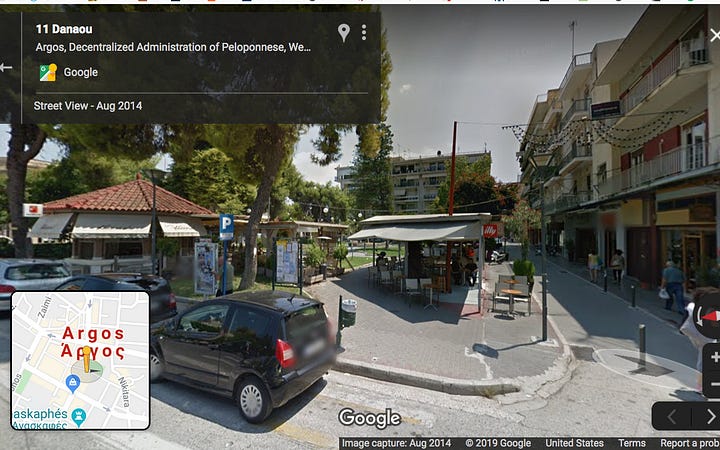
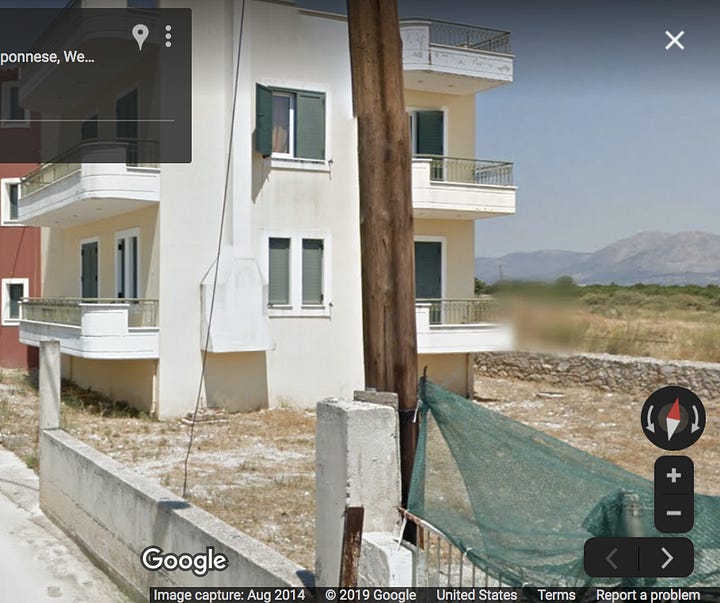
Just an ordinary Greek polis of 26,000 people. Nothing impressive.
But the city of Argos should impress us because it is 4000 years old.2
That’s two hundred generations of teenagers complaining there’s nothing to do, parents waking up to crying babies and sighing that they don’t live more glamorous lives, old folks fearing everything is going to ruin because of the teenagers and the parents. Argos has survived wars, famines, conquests, droughts, changes in language, culture, religion, economics, climate, and and of course empires. In other words, Argos and places like Argos are resilient, and much of their resilience lies in how they’re contructured.
When Charlottesville was created, as I mentioned in this post, it was common sense to build a city this way.
Buildings were often built up against one another with residences above and various trades, shops, or businesses below… This is the traditional pattern for building cities used since the Bronze Age: Buildings close or touching, residences above, work spaces below along narrow streets or alleys that open into public spaces.
Look at the pictures above and see how the residences sit over shops, how these little streets or alleys open into public spaces, and how there is a clear edge of town. Also note that none of the buildings are huge. All are between two and five stories.
I chose Argos because like Charlottesville it isn’t on a major body of water and doesn’t have a lot of political importance. But below is Nauplion (or Nafplion), Argo’s tonier port-city neighbor:
They’ve banned the cars in the tourist area, but the original building structure is still the same: residences over shops, buildings close together, on narrow streets that open into larger public spaces.
And it’s the same everywhere. Below are some screenshots from cities around the world:






I could have shown the older urban centers of New Orleans, Boston, San Francisco, or Charleston, SC, Paris, London, Florence, Rome, Prague, Jakarta, St Petersburg, Da Nang, Vietnam, or a thousand more. Different levels of economic importance and fame, different population sizes, different construction materials, but it’s the same underlying structure.
The cars can make it hard to see, and today most ‘cities’ have huge post-WWII highway networks surrounding these older grids (and sometimes cutting through them). We’ll talk about the cars and highways a few weeks, but for now I ask you to see the underlying structure. It’s one of the basic ways that humans live. Below are examples that show the narrow streets opening into wider public spaces:

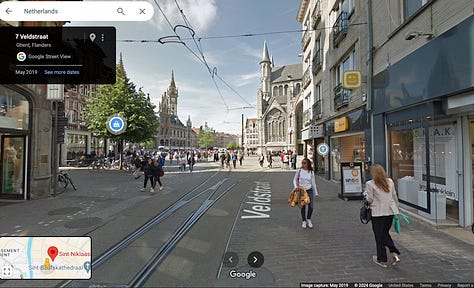

Why?
Building this way has a lot of advantages:
The Commuter Advantage. As I mentioned earlier this week, before cars the primary mode of transportation were feet (not horses), so a tight grid makes life easier and better. Whether you’re buying, selling, or socializing spending less time traveling means more time for the buying, selling, or socializing.
Public Works Advantage. Back in the day ten families spread out in rural countryside had to dig ten different wells. In a city or town they can dig one well. Before fossil fuels, only cities could afford utilities like public baths, aqueducts, and paved market squares. And even after fossil fuels tight grids are more cost effective because it takes vastly fewer miles of, say, water and sewer pipes to reach ten thousand urban people than it does ten thousand suburban or rural people.3
Specialization Advantage. This is really an expansion of #1 above: More people within walking distance allows more specialization—a greater variety of goods if you’re buying and customers for more unique products if you’re selling. Back in the day, a village had a blacksmith, but the bigger the town the more it could have a tinsmith, goldsmith, and many different blacksmiths with different specialties. In a city you can have furniture makers, jewelers, toymakers, bookbinders, newspaper publishers, teachers, medical specialists, and so on.
The Bad Side & the Upside of the Bad Side
Cities definitely have disadvantages. Noise, disease, pollution, and the annoyances of getting along with people come to mind.4 Also cities have to cope with a lot of problems they don’t cause—invading armies, the rural homelessness, taxation—as I alluded to here.
These problems mean cities really can’t escape government. Libertarian fantasies won’t solve neighbors arguing over noise, garbage, and who is responsible for a dying tree. All cities end up with governments, but there is an upside to this too:
Urban Freedom. Rural people get to be left alone and that’s a wonderful sort of freedom. Urbanites can’t escape the government, but then again the government can’t escape the urbanites. City leaders are always in walking distance of mob violence, and the result has been citizen often prying political power from the rich and powerful. This is the freedom of a city-dweller to participate in making the laws that govern the city-dweller. It doesn’t always happen in cities, but cities are just about the only place where it’s ever happened.
Cities produce a lot of great things: Writing and printing both came from cities. Most philosophy and literature. Most of the major religions: The Buddha may have gone to the countryside to find his noble truths but he was a city boy from Lumbini by birth. Every book of the New Testament was originally written by, about, and for city people. All the books of the Hebrew Bible were put into their current form by urban Jews living in Babylon, Alexandria, and Jerusalem. Islam came from the Arabian cities of Mecca and Medina. Many of these things—and the endless list of inventions, innovations, and scientific discoveries—came from small cities by the way. Some as small as Charlottesville.
Everyone knows that this traditional building pattern works. There’s something primordial about it. Disneyland and its many imitators are divided into themed areas (Fantasyland, Adventureland, Frontierland, etc.) that are almost always constructed so that they look like little traditional town. Stores often try to imitate it. Here’s the local Wegmans:

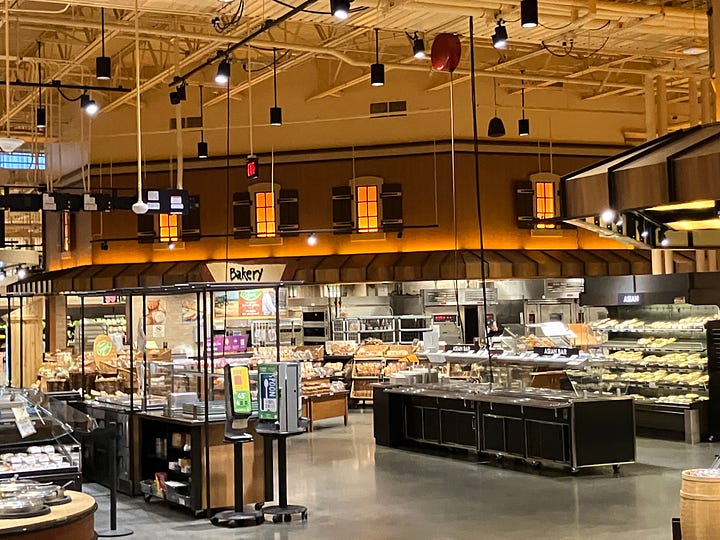
The point of Welcome to Charlottesville is certainly not that cities are the answer to everything, or that you, friend reader, should live in a city. Live where you want!
But it’s important to understand, especially as we look to the future of Charlottesville, that cites are resilient.
Back to the Mediterranean, here’s Byblos in Lebanon:5
Byblos has been a city for even longer than Argos. It’s been a city for seven thousand years. In that time the citizens of Byblos have been ruled by dozens of empires, changed their native language several times, converted to at least two different religions, and even been counted as part of multiple ‘civilizations’.6 Yet DNA extracted from ancient skeletons show that the modern citizens of Byblos are directly descended from their Bronze Age ancestors. The language and religion of the city didn’t change because one people disappeared and the next imigrated, but becasuse citizens of Byblos adopted new ways of speaking, worshipping, and living. Byblos survived, and not by holding on to their traditions and political loyalties, but by changing them.
Charlottesville too can outlast empires, languages, religions, and entire civilizations. Imagine a thousand years from now our descendants walking these same streets (They’ll definitely be walking when the oil runs out.), parents waking up in the middle of the night to crying babies, teenagers complaining that there’s nothing to do, old folks fretting about the parents and teenagers. Maybe a school group will pass through on a train (Sorry, the flying cars aren’t going to happen.) as the professor points out the window and says something the groggy kids don’t hear.
We’ll be back Tuesday with the continuation of Welcome to Charlottesville. Thanks for reading and please subscribe and share!
We were visiting the Argolid, the area that included Argos, the ruins of Bronze Age Myceneae, the classical theater of Epidauros, and the medieval city of Naupflion. Argos was the home of the mythical King Menelaus from whom Helen of Troy fled, and was the home of the semi-legendary King Pheidon who may have invented Phalanx warfare. After that, not much happened, though the town played a role in the Greek wars of independence in the 1820s.
And that’s just as a polis, the Greek word for city or town. The site was a contiguously occupied village for 3000 years before that.
A lot of urban amenities have been built through history by corvee or slave labor, but generally cities don’t have a worse record on slavery than whatever empires they’re ruled by, usually they are more free than the surrounding rural areas.
Disease, pollution, and getting along with other people can be a big problem outside of cities too, but the diseases, pollution, and difficulties with people are different, and cities have an inherent built-in noise problem.
This is the Phoenician (modern Lebanese) city-state from which the Ancient Greeks got their name for ‘book’, byblion (literally ‘the thing from Byblos’), from which we get the word bible:
The city spoke Phoenician, Aramaic, maybe Greek, and now Arabic. Byblos has been pagan and Christian (with many Muslims now). Byblos would have been part of Toynbee’s Hellenic, Syriac, and Islamic civilization.






From the air at night over the US in the 70's the contrast between organic city structure, grids and combinations was stark. Also, the highways connecting them. Fertile study demographically.